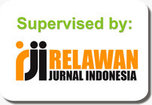Pemanfaatan Teknologi Machine Learning Untuk Klasifikasi Wilayah Risiko Kekeringan di Daerah Istimewa Yogyakarta Menggunakan Citra Landsat 8 Operational Land Imager (OLI)
Abstract
Drought is a natural disaster that occurs slowly and lasts a long time. Bantul and Gunung Kidul Regencies, Special Region of Yogyakarta are also areas affected by high drought risk. This happened because the area was the result of the construction of a cement factory and limestone mining along the Sewu Mountains. Prediction and classification of areas affected by drought can be done more accurately over large areas by extracting vegetation indices through remote sensing imagery. This research was conducted to provide information about the potential risk of drought in the region using Landsat 8 OLI spectral vegetation index data. Prediction or classification of drought potential using Artificial Neural Network. Vegetation index used in this study is NDVI, TCI, VCI, and VHI. Correlation results between vegetation indices showed the highest correlation occurred between the vegetation index TCI and VHI with the potential for a medium drought of 0.501 and the potential for a high drought of 0.684. Also obtained are the results of the classification of 9 villages that fall into the category of high drought potential (High Risk). Accuracy results and Kappa values indicate that Random Forest is the best method used with a breakdown of values of 99.91% and 99.81%, respectively. Spatial prediction results are performed using Inverse Distance Weighted (IDW) on vegetation index and prediction. Testing of spatial relationships between villages that have the potential for drought is done using Moran s I. analysis.
Keywords
Full Text:
PDF (Bahasa Indonesia)References
M. R. Amri, Indeks Risiko Bencana Indonesia. Jakarta: BNPB, 2016.
L. Kurniawan, S. Triutomo, R. Yunus, M. R. Amri, and A. A. Hantyanto, Risiko Bencana Indonesia, 1st ed. Direktorat Pengurangan Risiko Bencana Deputi Bidang Pencegahan dan Kesiapsiagaan, 2014.
P. Togatorop, S. Subiyanto, and A. Wijaya, Pemetaan Potensi Bencana Aliran Lava Gunung Sinabung Menggunakan Citra Aster Gdem, J. Geod. Undip, Vol. 5, No. 2, Pp. 87 96, 2016.
D. Hastuti, Sarwono, and C. Muryani, Mitigasi Kesiapsiagaan dan Adaptasi Masyarakat terhadap Bahaya Kekeringan Kabupaten Grobogan, J. GeoEco, Vol. 3, No. 1, Pp. 47 57, 2017.
F. Rahman, A. Sukmono, and B. D. Yuwono, Analisis Kekeringan Pada Lahan Pertanian Menggunakan Metode NDDI dan Perka BNPB Nomor 02 Tahun 2012 (Studi Kasus: Kabupaten Kendal Tahun 2015), J. Geod. Undip, Vol. 6, No. 4, Pp. 274 284, 2017.
I. Nuarsa, I. Adnyana, and A. As-syakur, Pemetaan Daerah Rawan Kekeringan Di Bali-Nusa Tenggara Dan Hubungannya Dengan Enso 2) Menggunakan Aplikasi Data Penginderaan Jauh, Bumi Lestari, Vol. 15, No. 1, Pp. 20 30, 2015.
I. Sholikhati, D. Harisuseno, E. Suhartanto, M. Program, M. Teknik, and P. Universitas, Studi Identifikasi Indeks Kekeringan Hidrologis Pada Daerah Aliran Sungai ( Das ) Berbasis Sistem Informasi Geografis ( Sig ), 2008.
A. A. Ashazy and A. B. Cahyono, Analisis Indeks Vegetasi Menggunakan Citra Satelit Formosat-2 Di Daerah Perkotaan (Studi Kasus: Surabaya Timur), Geoid, Vol. 9, No. 1, p. 88, 2013.
S. N. Lufilah, A. D. Makalew, and B. Sulistyantara, Pemanfaatan Citra Landsat 8 Untuk Analisis Indeks Vegetasi Di Dki Jakarta, J. Lanskap Indones., Pp. 73 80, 2017.
E. K. Andana, Pengembangan Data Citra Satelit Landsat-8 Untuk Pemetaan Area Tanaman Hortikultura Dengan Berbagai Metode Algoritma Indeks Vegetasi (Studi Kasus: Kabupaten Malang Dan Sekitarnya), Nas. Manaj. Teknol., Vol. 9, No. Sistem Informasi Geografis, Pp. 1 10, 2015.
D. Amliana, Y. Prasetyo, and A. Sukmono, Analisis Perbandingan Nilai NDVI Landsat 7 Dan Landsat 8 Pada Kelas Tutupan Lahan (Studi Kasus : Kota Semarang, Jawa tengah), J. Geod. Undip, Vol. 5, No. 1, Pp. 264 274, 2016.
F. S. Wirandha, Marwan, and Nizamuddin, Klasifikasi Penggunaan Lahan Menggunakan Citra Satelit Spot-6 di Kabupaten Aceh Barat, Semin. Nas. dan Expo Tek. Elektro 2015, 2015.
WMO and GWP, Handbook of Drought Indicators and Indices (M. Svoboda and B.A. Fuchs). Integrated Drought Management Programme (IDMP). Integrated Drought Management Programme (IDMP), Integrated Drought Management Tools and Guidelines Series 2. Geneva., No. 1173. 2016.
S. Yulianto, J. Prasetyo, S. Silvianugroho, K. D. Hartomo, and J. Diponegoro, Penentuan Wilayah Resiko Bencana Kekeringan di Jawa Tengah Menggunakan Machine Learning dan Indeks Vegetasi pada Citra Landsat 8 OLI, Indones. J. Comput. Model., 2018.
F. N. Kogan, Global Drought Watch from Space, Bull. Am. Meteorol. Soc., Vol. 78, No. 4, Pp. 621 636, 1997.
A. Setyono and S. Novianto, Penerapan Interpolasi Linier Untuk Deteksi Garis Lurus Pada Citra, TechNo.com, Vol. 12 No. 3, No. 3, Pp. 143 149, 2013.
Z. Ibrahim, D. Isa, R. Rajkumar, and G. Kendall, Document zone content classification for technical document images using artificial neural networks and suPport vector machines, 2nd Int. Conf. APpl. Digit. Inf. Web Technol. ICADIWT 2009, Issue. September, Pp. 345 350, 2009.
H. D. Purnomo, K. D. Hartomo, and S. Y. J. Prasetyo, Artificial Neural Network for Monthly Rainfall Rate Prediction, J. Phys. Conf. Ser., Vol. 755, No. 1, 2016.
S. Yulianto, J. Prasetyo, K. D. Hartomo, and M. C. Paseleng, Satellite Imagery and Machine Learning of Autocorrelation for Aridity Disaster Risk Classification using Vegetation Indices, Vol. 9, No. 3, Pp. 1 16, 2015.
G. Garnero and D. Godone, Comparisons between different interpolation techniques, Int. Arch. Photogramm. Remote Sens. Spat. Inf. Sci. - ISPRS Arch., Vol. 40, No. 5W3, Pp. 139 144, 2013.
DOI: http://dx.doi.org/10.26623/transformatika.v18i1.2140
Refbacks
- There are currently no refbacks.
| View My Stats |
Jurnal Transformatika : Journal Information Technology by Department of Information Technology, Faculty of Information Technology and Communication, Semarang University is licensed under a Creative Commons Attribution 4.0 International License.









